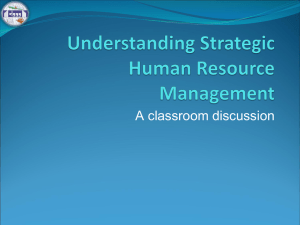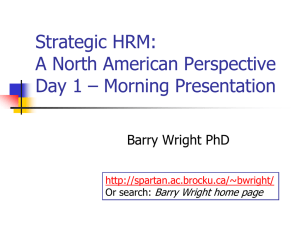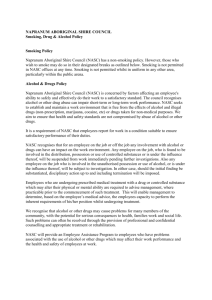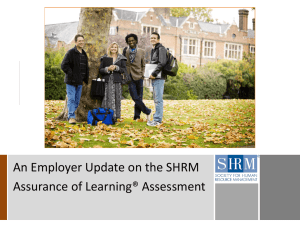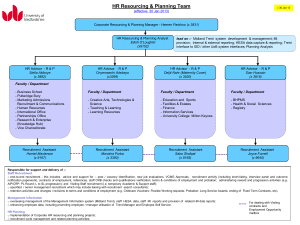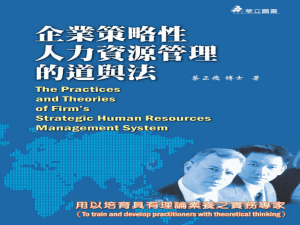recruitment and selection
advertisement
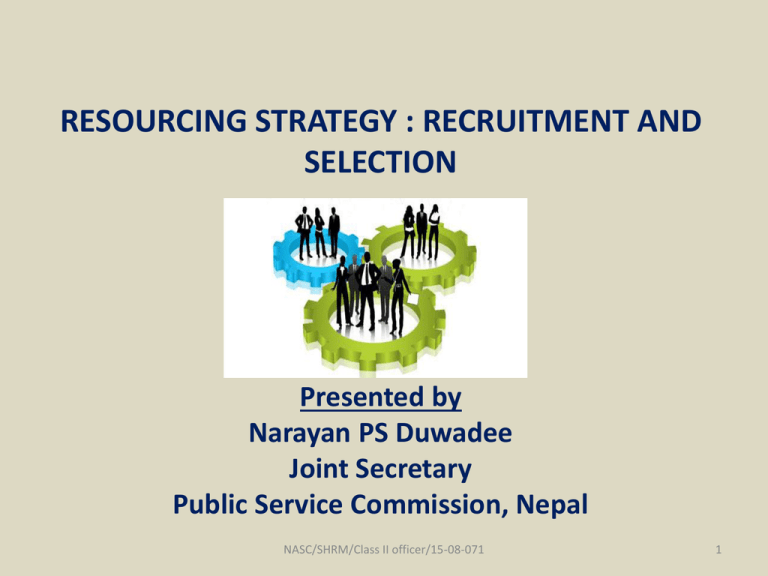
RESOURCING STRATEGY : RECRUITMENT AND SELECTION 1 Presented by Narayan PS Duwadee Joint Secretary Public Service Commission, Nepal NASC/SHRM/Class II officer/15-08-071 1 PRESENTATION OUTLINE • • • • • • • • • • HRM Process Employee Resourcing Strategy (ERS) The objective of ERS The component of ERS Resourcing plans Group excercise/ break /followed by group presentation Recruitment and Selection Recruitment and selection in civil service of Nepal Challenges and Challenges and Future perspectives Conclusion NASC/SHRM/Class II officer/15-08-071 2 HRM PROCESS (1) NASC/SHRM/Class II officer/15-08-071 3 HRM PROCESS (2) NASC/SHRM/Class II officer/15-08-071 4 EMPLOYEE RESOURCING STRATEGY (ERS)..1 Employee resourcing Strategy: Key of HRM process As the ‘nuts and bolts’ of HRM practice Ensuring the acquisition and retention of employee as per organization's need Employing the people efficiently Matching HR to strategic and operational needs of the organization Ensuring full utilization Concerned with obtaining, keeping as well as selecting and promoting people who fit the culture and strategic requirements of the organization. NASC/SHRM/Class II officer/15-08-071 5 EMPLOYEE RESOURCING STRATEGY (ERS)..2 The HRM approach to resourcing emphasizes that matching resources to organizational requirements does not simply mean maintaining the status quo and perpetuating a dying culture. It can and often does mean radical changes in thinking about the skills and behaviours required in the future to achieve sustainable growth and cultural change. • The philosophy behind the strategic HRM approach to resourcing is that it is people who implement the strategic plan i.e. ‘planning with people in mind’. NASC/SHRM/Class II officer/15-08-071 6 THE OBJECTIVE OF ERS To obtain the right basic material in the form of a workforce endowed with the appropriate qualities, skills, knowledge and potential for future training. Ensure that an organiztion achieves competitive advantage by employing more capable people than others. NASC/SHRM/Class II officer/15-08-071 7 HUMAN RESOURCE PLANNING/WORKFORCE PLANNING....1 ‘hard’ and ‘soft’ human resource planning Answer the questions as • 1) how many people? • 2) what sort of people? • 3) In what ways people are employed and developed inorder to improve organizational effectiveness. NASC/SHRM/Class II officer/15-08-071 8 THE COMPONENTS OF ERS Human resource planning Developing the organization’s employee value proposition and its employer brand. Resourcing plans Retention strategy Flexibility strategy Talent management strategy NASC/SHRM/Class II officer/15-08-071 9 HUMAN RESOURCE PLANNING/WORKFORCE PLANNING...2 In other words HR planning is ‘a decisionmaking process that combines three important activities: • Identifying and acquiring the right number of people withthe proper skills, • motivating them to achieve high performance, and • creating interactive links between business objectives and peopleplanning activities’. NASC/SHRM/Class II officer/15-08-071 10 HUMAN RESOURCE PLANNING/WORKFORCE PLANNING...3 • HR plan converted into actionplans based on the outcome of the following interrelated planning activities NASC/SHRM/Class II officer/15-08-071 11 RESOURCING PLANS..1 Internal resourcing should be based on data already available about skills and potential. This should have been provided by regular skills audits and the analysis of the outcomes of performance management reviews. External resourcing requirements can be met by developing a recruitment strategy. NASC/SHRM/Class II officer/15-08-071 12 RESOURCING PLANS..2 The aim of the strategy should... make the organization‘the employer of choice’ plan the best methods of defining precisely what is needed in terms of skills and competencies. be concerned with planning the use of the most effective methods of obtaining the number and type of people required. NASC/SHRM/Class II officer/15-08-071 13 RESOURCING PLANS: PROCESS ORGANIZATIONAL CULTURE ORGANIZATIONAL CULTURE WORKING ENVIRONMENT AND HUMAN RELATION NASC/SHRM/Class II officer/15-08-071 14 RECRUITMENT AND SELECTION...1 Recruitment Selection Recruitment is the process of generating a pool of capable people to apply for employment to an organisation. Selection is the process by which managers and others use specific instruments to choose from a pool of applicants a person or persons more likely to succeed in the job(s), given management goals and legal requirements.’ Group Work announcement NASC/SHRM/Class II officer/15-08-071 15 Group Excercise • Voluntarily form the group- 2 min • Distribute the theme for discussion - 2 min • Theme 1- Recruitment policy and its importance • Theme -2- Best Selection techniques to acquire the desired employees • Theme-3- Current practices of Recruitment and selection in civil service (Nepal) • Theme- 4- Expected role of PSC and receiving agencies to make R&S more effective • Discuss and make short 5-10 points- 5 min • Presentation by each group 1 min each NASC/SHRM/Class II officer/15-08-071 16 • presentations start 1.05 • session resume at 1.10 NASC/SHRM/Class II officer/15-08-071 17 RECRUITMENT AND SELECTION..2 Recruitment searching for prospective employees and stimulating them to apply provides the sufficient pool of candidates to select qualified employees Negative recruitment Positive recruitment best among those who could apply Talent haunt Selection estimate the ability of the candidates thruogh different selection techniques and criteria. NASC/SHRM/Class II officer/15-08-071 18 RECRUITMENT AND SELECTION..2 Recruitment and selection forms a core part of the central activities underlying human resource management: namely, the aquisition, development and reward of employees. Explore methods not only of recruiting the number of people required but also of finding staff who have the necessary skills and Experience, who are likely to deliver the desired sort of behaviour and who will fit into the organization’s culture readily. ‘If the HRM function is to remain effective, there must be consistently good levels of teamwork, plus ongoing cooperation and consultation between line managers and the HR manager.’ NASC/SHRM/Class II officer/15-08-071 19 RECRUITMENT AND SELECTION..3 The recruitment and selection of employees is fundamental to the functioning of an organisation, and there are compelling reasons for getting it right. Inappropriate selection decisions reduce organisational effectiveness, invalidate reward and development strategies NASC/SHRM/Class II officer/15-08-071 20 RECRUITMENT AND SELECTION PROCESS..1 Recruitment and selection is often presented as a planned rational activity,comprising certain sequentially-linked phases within a process of employee resourcing NASC/SHRM/Class II officer/15-08-071 21 RECRUITMENT AND SELECTION PROCESS..2 The processes and techniques will include the use of: •Skills analysis •Competency mapping •Biodata •Structured interviews •Psychometric testing •Assessment centres NASC/SHRM/Class II officer/15-08-071 22 RECRUITMENT AND SELECTION IN CIVIL SERVICE OF NEPAL Basic Principles Merit based selection ( academic excellence, inclusive and sustainable) Fair and Impartial competition Total blind system/Confidentiality - Double coding - Confidentiality about expert involved - Involvement in only one step of selection Sustaining Peoples’ trust NASC/SHRM/Class II officer/15-08-071 23 RECRUITMENT AND SELECTION IN CIVIL SERVICE OF NEPAL Recruitment General intake from eligible pool Screening negative recruitment Selection GMAT Knowledge test: written examination Skill test Personality test NASC/SHRM/Class II officer/15-08-071 24 RECRUITMENT AND SELECTION IN CIVIL SERVICE OF NEPAL Process Curriculum design Collection of vacancies Determination of the methods for selecting candidates to fill in vacancies Advertising notices Application registration Construction of question papers Conduction of written tests Declaration of the result of written tests Practical tests Interview The final selection of the candidate Recommendation for appointment NASC/SHRM/Class II officer/15-08-071 25 RECRUITMENT AND SELECTION IN CIVIL SERVICE OF NEPAL Process Flow chart NASC/SHRM/Class II officer/15-08-071 26 CHALLENGES Integration of HR policies and practices with the performance result of the organization Making the image of civil service more attractive Effective collaboration of CPA and recruiting agency Noncomparision of government service with any other private jobs Devising the competency based selection techniques Injecting new technologies and methods in selection process Maintaining credibility in changing socio-political context Technical and ecological readiness for positive recruitment NASC/SHRM/Class II officer/15-08-071 27 FUTURE PERSPECTIVES Fundamental shift in the structural and functional modalities of of civil service, eg ministerial services; HR flexibility and autonomy Making government job more attactive through different reform initiatives Implementation of PBMS Use of ICT in recruitment and selection Consultation with varieties of expert Close and active interaction with government to make job description, academic qualification and recruiting curriculum(PSC) corresponding each other. NASC/SHRM/Class II officer/15-08-071 28 CONCLUSION • PSC and civil service of Nepal is the institution with high degree peoples' trust because of its merit based, fair and confidential selection process. • Despite this high credibility, question can be asked; why do such a meritorious employees are not able to reflect it into their performances? • The PSC’s selection can be really justified only when people can feel in their dailies through the performance of PSC ‘product’ even though performance is dependent with too many other factors. • So finding more accurate selection method and best candidate, making the procedure easier and predictable and bring PSC more closer to the people should be the future agendas of reform in any recruiting agencies. NASC/SHRM/Class II officer/15-08-071 29 Any Querries and Comments? NASC/SHRM/Class II officer/15-08-071 30
